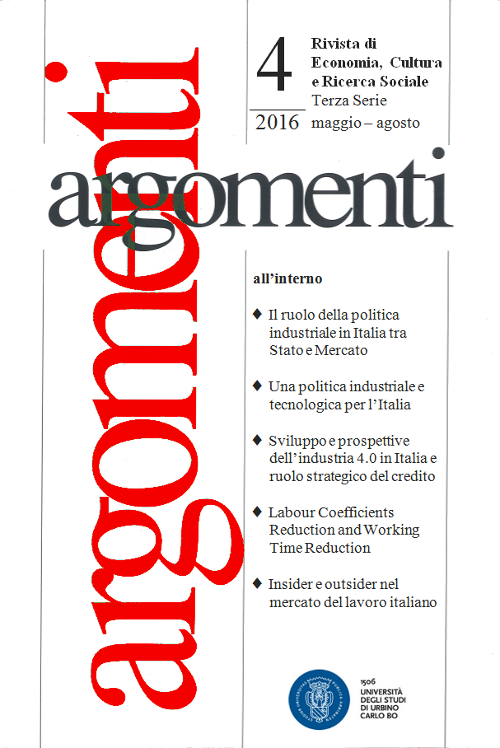Abstract
The present path and nature of technological innovation is such as to reduce dramatically the labour coefficients in the production processes nearly in every sector and surely in the productive system taken as a whole. This issue, which is linked to the concept of “technological unemployment” evoked by Keynes, is considered both under a theoretical and an empirical perspective, and it leads to explore the most viable way out of the problem of this kind of unemployment, which is the shortening of the working time. The paper explores the complexity, the technical problems and some policy implications of this solution. Finally, some intermediate, less radical, measures in this direction are considered.
Riferimenti bibliografici
References
Ball, L., G. Mankiw, 2002, The Nairu in Theory and Practice, Journal of Economic Perspectives, vol. 16(4) 115-136.
Benigno P., Ricci L., and Surico P.(2010) Unemployment and Productivity in the Long
Run: the Role of Macroeconomic Volatility, IMF Working Paper, n. 259
Blanchard O., Solow R., Wilson B.A. (2007), Productivity and Unemployment, MIT Economics, Blanchard Papers
Bowles J. (2014) The Computerisation of European Jobs, Bruegel 2014
Brenke K.,Rinne U., Zimmermann K.F. (2011) Short-Time Work: The German Answer to the Great Recession, IZA Discussion paper n.5780
Brynjolfsson, E., and A. McAfee.2011. Race Against the Machine. Lexington, MA: Digital Frontier Press.
Chun-chieh Huang, Juin-jen Chang, Ching-chong Lai and Chung-cheng Lin (2002), Worker Productivity, Working Time Reduction, And The Short-Run And Long-Run Employment Effects, in Scottish Journal of Political Economy, n. 4
Clower R.W. (1965) The Keynesian counter-revolution: a theoretical appraisal, in
Hahn F., Brechling F. (edts.) The Theory of Interest Rates, Macmillan
Erixon L. (2008) “The Rehn-Meidner Model in Sweden: Its Rise, Challenges and Survival.” Stockholm University (2008)
Fadda S. (2015), Income inequality. What Causes It and How to Curb It, forthcoming in: Fadda S., Tridico P. (eds), Varieties of Inequality, Routledge
Fadda S. (2013) Produttività, Contrattazione e Patto Sociale, in Quaderni di Rassegna Sindacale, 2013, n.2
Ford. M (2009), The Lights in the Tunnel, Acculant Publishing
Frey C., Osborne M. (2013) The Future of Employment, Oxford Martin School WP
Gordon R. (1995) Is there a Trade Off Between Unemployment and productivity growth?, NBER Working Paper n.5081
Keynes J. M. (1930), “Economic Possibilities for Our Grandchildren” in Essays in Persuasion, W.W. Norton & Co, 1963
Keynes J. M.(1967) ) The General Theory of Employment, Interest and Money,
Macmillan
Keynes J. M. (1973) Collected Writings of John Maynard Keynes, vol. 14, Macmillan, St Martin Press for the Royal Economic Society
Layard, R., Nickell, P.R.G. and R. Jackman (1991) “Unemployment: Macroeconomic Performance and the Labour Market” Oxford University Press,
Pasinetti L. (1993) Dinamica Economica Strutturale, Il Mulino
Pissarides, C. A. (2009) The Unemployment Volatility Puzzle: Is Wage Stickiness the Answer?, Econometrica, 77: 1339.1369
Rifkin J. (1995), The end of work, Tarcher / Putnam
Rotman D. (2013) How Technology is Destroying Jobs, MIT Technology Review, June 12, 2013
Rowthorn, R. (1999) Unemployment, Wage Bargaining and Capital labor substitution Cambridge Journal of Economics 23(4)
Russel B. (1935) In Praise of Idleness and Other Essays, Allen and Unwin
Valli V. (1996) (a cura di) Proposte eretiche per l’occupazione, Rosenberg & Sellier
L'opera è pubblicata sotto Licenza Creative Commons - 4.0 International (CC BY 4.0)





